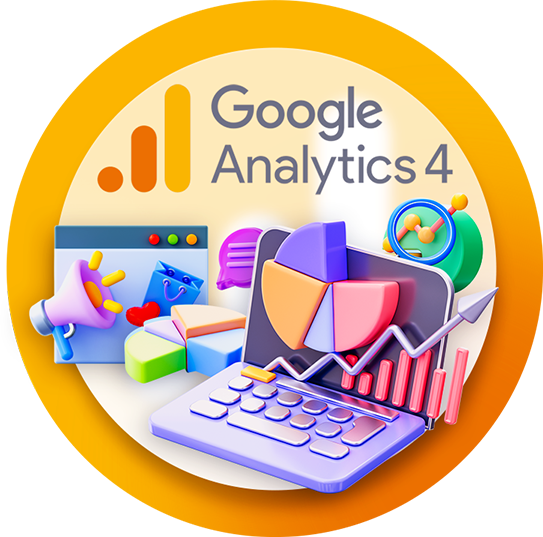What is website positioning?
The term website positioning refers to methods used to improve the position of a website in search engines, i.e. websites such as Google, Yahoo! or Bing. In this way, the aim is to obtain much more traffic on the website and ultimately translate it into sales of products and services.
In Poland, the Internet search engine most frequently chosen by users is Google – over 96% of Internet users use its services. Therefore, the vast majority of issues related to positioning in our country relate to the requirements set by Google.

Who needs website positioning?
Every business that wants to be visible online and wants to acquire customers via the Google search engine needs positioning. There are various techniques and strategies to achieve this goal, their selection depends on the industry, content and target we want to reach with our website.
What does a positioning service consist of?
Positioning is a complex and long-term process, it consists of many different elements. Basically, they are divided into two segments – On site and Off site. The first one covers all optimization activities directly on the website, the second one concerns building the domain’s reputation by acquiring valuable links.
What is website positioning?
The simplest answer to this question will be to say that website positioning involves influencing the organic search results of Google by working on your website. In practice, the topic is, of course, much more complex.
Let’s start with how the Google search engine works
We all know what it looks like from the user’s perspective – we go to google.pl, enter a phrase or ask a question and we get dozens of results related to the topic we are interested in.
And what does it look like from the other side?
The operation of the search engine is based on a robot that scans all websites whose owners have included information in the code that they want them to be indexed. Then Google, using its algorithms, verifies whether a given website meets the on-site and off-site requirements it sets for them. On this basis, a ranking of results answering the user’s question is created.
Therefore, in order to be high in the organic search results, we must find out what requirements Google places on webmasters and try to meet them as best as we can. So let’s start on-site activities that will help us stand out among the organic competition in our industry.
On-site activities include the optimization of our website, which is a complex and multi-faceted process. The first step in this type of activities is a thorough audit of the website, which includes, among others, such elements as: verification of the correctness of the head section, quantity and quality of content on the website, originality of the content, keyword content in the content, correctness of sitemap.xml and robots.txt files. , loading time and site weight, correctness of image descriptions, friendliness of internal links, analysis of outbound links from the site, related domains and redirects, software up-to-date, links to the site, domains pointing to the site, keywords related to the site, backlink profile history.
Each website audit results in optimization recommendations, the implementation of which is the second stage of SEO activities.
Once our website meets all Google requirements for webmasters, we can move on to implementing our SEO strategy.
What can be the website positioning strategies?
There are many positioning strategies based on the selection of different types of keywords. When choosing the right one for our company, we should take into account such elements as: the direct goal we want to achieve through SEO activities (e.g. increasing sales), indirect goals (e.g. increasing website traffic, especially important if we display AdSense ads on it) , what activities our competition is conducting and with what results, the industry in which we operate, our target group of customers and, of course, the monthly budget.

Generic keywords
For many years, SEO activities focused only on generic keywords. What we mean here is short one or two-word phrases generally referring to our product or service. They are characterized by a high number of monthly searches and a very high level of generality. A person who searches for such a phrase is interested in a given type of product or service, but has not yet specified the „parameters” of his need.
The phrase „mountain bike” can serve as an example. Its monthly potential is over 27,000 searches. We can assume that a person who enters such a phrase in Google is interested in purchasing a bicycle, but we do not know whether the bicycle in question is to be e.g. new or used, for recreational or professional use, what brand, etc. Therefore, if we sell new recreational bicycles and position ourselves Such a general phrase may be used by users for whom our website will be the right place, but also by those who need something else.
Generic phrases, due to their specificity, have the highest competition because they cover a wider range of topics, so naturally more companies may be interested in appearing in the top 10. This makes the positioning of this type of phrases the most expensive compared to other types of keywords .
When is it worth positioning generic phrases?
First of all, when we want to gain a lot of traffic to our website, which we then want to channel in various directions. An additional advantage of visibility for such phrases is, of course, the image effect – appearing high on general keywords is still associated with professionalism by many Google users, according to the principle that if something is not on the first page of organic results, it does not exist.
When positioning generic phrases, the budget is also important – in the case of a larger budget, it is worth choosing this type of phrases, however, when our budget is small and generic words are very popular in our industry, it is worth considering the selection of a different type of strategy.
Long tail keywords
The long tail keyword positioning strategy, also known as the long tail in Polish, is based on long, multi-word and highly specific queries. Such phrases are characterized by a low search volume, but very often a high conversion rate.
The way Google users search for information is evolving, they are increasingly entering very precise queries into the search engine window so as not to wade through the information chaos when their need is very specific.
We can again use the example of a person looking for a mountain bike. If such a person’s needs are already specified and they know what their expectations are, we can most likely say that they will enter a long-tail phrase in Google. Such a phrase could be, for example, „new recreational mountain bike up to PLN 3,000”.
It is in our interest to cover as many of these types of queries as possible with the content on our website. Why? Because the user entering such a phrase already has a purchase intention, we need to convince him to make a transaction in our store.
When is it worth positioning long tail phrases?
First of all, when we run e-commerce. For every online store, long tail activities should be an ironclad basis if we want users to notice our products.
The second interesting case is introducing a new product or service to the market. If we go out into the world with something completely innovative that has not been popular before, keywords generally related to our business will not have any search potential. So how to reach users using SEO activities in such a case?
By selecting keywords and queries indirectly related to our activities and including them in the content on the website. Selecting a large number of these types of long tail phrases can generate traffic on the website, which we can redirect directly to our product using properly constructed content.

The third case when it is worth considering this type of activities is if you have a limited budget for SEO activities. Long tail phrases usually have lower competition, so you can position much more of them at a lower budget than in the case of generic phrases, achieving a similar effect.
Keywords like "How to...?"
These types of keywords in Polish are simply questions starting with How…? What…? What…? What…? They have similar characteristics to long tail phrases, they are long and have a smaller number of monthly searches. Users enter them in the search engine when they want to know a specific answer to a question that bothers them. An example is the phrase „how to choose the right mountain bike for a child?”.
When is it worth positioning these types of phrases? In this case, the answer is – always. Any product or service that can be purchased online can generate questions from potential customers.
It is worth considering what questions these might be and posting them on your website. This will not only generate more organic traffic, but will also increase the satisfaction of customers who will quickly get answers to their questions and will be encouraged to convert. An additional bonus will be a smaller number of the same inquiries to the customer service department.
The third case when it is worth considering this type of activities is if you have a limited budget for SEO activities. Long tail phrases usually have lower competition, so you can position much more of them at a lower budget than in the case of generic phrases, achieving a similar effect.
Branded keywords
All keywords containing the brand name are usually considered branded. Positioning such phrases for websites selling products and services under their own brand is usually very simple. In most cases, only good website optimization is enough, additional external linking will not even be necessary.
The situation is slightly different in the case of positioning brand phrases, e.g. in online stores that sell many manufacturers who also appear on other websites. Here, the type of action needed to be taken depends on the type of brand word, whether it is more like a generic phrase (e.g. „Merida bike”) or a long tail phrase (e.g. „MERIDA CLASSICWAY bike).
The third case when it is worth considering this type of activities is if you have a limited budget for SEO activities. Long tail phrases usually have lower competition, so you can position much more of them at a lower budget than in the case of generic phrases, achieving a similar effect.
How does link building affect positioning?
Link building is one of the most important aspects of SEO. This is a process in which links from other domains are obtained, leading to our website.
What factors should be taken into account when building a link building strategy?
We need to take several factors into account. One of them is the Page Authority of the site from which the links come from. A page’s authority is determined by many factors, including the quality and quantity of links coming to that page. It’s also important to consider the link’s context – where it appears on the page and how it relates to the text surrounding it.
Another important factor to consider is the link’s anchor text. Anchor text is the text you click on to open a link and is an important signal to search engines. Make sure your anchor text is relevant and informative, and not just repeating your target content.
However, our role does not end with obtaining links.

It is worth keeping in mind what changes are taking place in the site’s position and monitoring both individual links and the entire link profile.
How to do it?
There are several ways to monitor the links to your site. One way is to use a link monitoring tool like Ahrefs or Majestic. This tool will provide you with information about your website’s link profile, including the number of backlinks and referring domains.
Another way to monitor links is to use Google Search Console. In GSC you can see all incoming links to the website, any errors occurring in the links as well as the number of views and clicks they generated.
Appropriate link building activities help improve the website’s position in the SERP, increase website traffic and build the website’s authority.
What are the types of links?
There are different types of inbound links, and each of them has a different impact on your SEO efforts. At least in theory.
The most popular types of inbound links are:
· Dofollow links – are the most valuable type of links for SEO. These are links that convey link juice (i.e. link authority) and help improve your SEO ranking.
· Nofollow links – in theory, they do not provide value to your website, but they help create a diversified link profile to make it look as natural as possible, which is why they are important in building a link building strategy. Even though their impact is lower than dofollow links, they are still valuable for SEO.
· Sponsored links – sponsored links are paid links. They are less valuable to SEO than organic and even nofollow links, but they can still help improve your SEO rankings.
How does internal linking affect positioning?
Internal linking is a great way to improve your rankings and also make it easier for visitors to navigate your site. By including links to other pages on your website, you inform Google that they are important and should be included in search results for related queries.
Internal linking also helps keep visitors on your site longer by giving them more opportunities to explore. And the more time they spend on the website, the more likely they are to become customers.
To diversify linking on the website, we can use various methods. The most popular are:
· linking directly in the content of the blog entry or category description – placing links to the category or product described in the text will make it easier for users to go to specific subpages
· modules linking to related blog articles or the most popular products – a good solution is to place graphics and basic information about the product or entry – this will attract users’ attention and make it easier for them to navigate the website
· breadcrumbs – it is worth implementing the so-called breadcrumbs on your website, which are clickable elements and redirect users to a higher category or the home page
· footer – in addition to contact information and links to social media, it is worth placing links to the most popular categories or the entire menu here.
Optimizing graphics in the website positioning process
Image optimization is an extremely important aspect of SEO. There are a few key things to keep in mind when customizing the images on your website.
Title and Alt attributes
Make sure your alt and title tags are accurate and descriptive – names that accurately reflect the subject of the image will help both users and search engines understand what the image is about. It is good practice to include keywords appropriate for a given subpage.
Graphic name
The name of the image on the page should accurately describe its subject. It is also worth including keywords here that are important for the website being positioned.

Please remember that we cannot use Polish characters and a dash as a separator in the graphic file name.
Size and format of graphics
The size and format of images placed on a website are particularly important in terms of page loading speed. Too large graphics and outdated formats burden the website and slow down its performance.
The most optimal solution is to use new generation formats such as JPEG2000, JPEG XR or WebP. It is also worth using the lossless compression option to reduce the weight of the photo without significant loss of quality.
The impact of content marketing on positioning
If you want your website to rank high in the search engine, you need to ensure good content on your website. Content strategy is one of the most important aspects of SEO, which can help you achieve better rankings and at the same time increase website traffic.
What do you need to remember in the content creation process?
· ensure a good Content Plan – analyze the market, competitors’ activities and the needs of your recipients. Based on the conclusions drawn, plan the topics and schedule of content you want to post on your website
· select and use keywords relevant to a given topic – remember to place them in the appropriate context and the optimal number of keywords in the content
· adapt the language and style of writing content to the potential group of recipients – think about who constitutes your largest audience and what information they are looking for on your website, and then create content in a way that is understandable and adequate to a given group
· create content of appropriate length – adjust the number of characters to the text you are creating for the page. Different values will be optimal for a blog entry, different ones for a category and product description. Make sure that the length of a given text allows for exhaustion of the topic and adequate saturation with key phrases.
· avoid duplication – remember that the Duplicate Content phenomenon is a serious obstacle in the website positioning process. Google’s algorithms easily detect such situations, which negatively affect the website’s visibility in the search engine and reduce the credibility of the website.
Blog positioning
When optimizing your blog for SEO, you must take into account all the above-mentioned factors affecting the content. But it is not everything.
In addition to creating unique, valuable content that will attract users’ attention, remember to complete the website’s meta data.
Well-chosen title and description attributes indicate the topic of the entries and contain keywords for which a given page is positioned. Don’t forget to include a Call to action message in the description, which will encourage users to read the article.
Also pay attention to the URLs of blog posts. They should be transparent and contain a shortened or full title of the blog article without Polish characters. This way, they will be readable by both recipients and search engine robots.
An additional advantage will be the implementation of internal linking throughout the blog. You can use linking directly in the text, placing links to products or categories mentioned in the content of the post. An interesting solution, also from a UX point of view, are boxes linking to related entries or products mentioned in the content. They attract the user’s attention with information included in the module (e.g. rating of an entry or product, interesting graphics) and encourage them to move to subsequent pages of the website.
Also remember to monitor your blog’s activity using the available tools offered by Google (Google Analytics, Google Search Console).
Thanks to them, you can obtain information about which blog entries are the most popular, how much time users spend on specific subpages and which pages they go to after reading the content of the entry.
Local positioning
If you are a business owner looking to attract more local customers, you should optimize your website for local SEO.
Implementing a few basic optimization elements will have a positive impact on the position of your website in the search engine, increase website traffic and the recognition of your business in the area, which will translate into higher income.
Where to start with local positioning?
The first step in Local SEO activities should be a thorough analysis in terms of key phrases, competition activities and the current market situation. It is also important that the basic SEO elements on the website are properly optimized.

On-site activities that can support local positioning include primarily the implementation of structured data. Thanks to them, search engine robots will find the most important information more easily and display it appropriately in the search results.
The most important elements that should be taken care of in the local positioning of your website is the creation of a Google My Business card.
This is a free service thanks to which the most important information about your business will appear in the search results. It should include data regarding NAP (company name, exact location, telephone number) and website, opening hours as well as the industry and amenities offered to customers.
Additionally, a properly configured business card displays user ratings and comments as well as seasonal products or current promotions.
This information is particularly important from the user’s point of view and can encourage potential customers to visit your website.
We should also not forget about users using the mobile version of the website. Currently, over 70% of local searches come from smartphones. It is worth ensuring that the website is properly optimized in the mobile version to make it as accessible as possible for users using this type of devices.
Positioning of online stores
Over the last few years, a large number of stores have moved their operations to the Internet or started selling online in parallel with stationary stores.
This has resulted in a significant increase in competition for e-commerce platforms that have been operating in the online world for a long time.
So how can you break through the competition and improve your store’s position in the SERP?
In addition to marketing activities such as advertising campaigns or social media activity, it is also worth taking care of SEO-related elements.
As with other websites, an online store requires both on-site and off-site activities. Combining these elements is crucial and allows you to achieve better results.
In addition to standard SEO activities, online stores should pay special attention to the website’s UX. The user experience after entering the website, clear navigation and easy process of adding products to the cart will certainly have a positive impact on the purchase decision and thus increase the conversion rate.
Therefore, it is worth considering not only how to attract users to the website, but also how to keep them there and encourage interaction.
You should ensure proper optimization of product subpages, because it is their sales that we care about.
How to do it?
· adjust the meta title and description of product pages to include keywords related to the product, its name, features and Call to action encouraging purchase
· optimize the graphics presenting the product – make sure that the product is well exposed and complete the title and alt attributes in accordance with SEO principles
· check how product pages are visible on mobile devices and whether elements that are important from the purchasing point of view (e.g. Buy now button, Add to cart, Check availability, etc.) are easily accessible and clickable on different screen resolutions
· remember about redirections – if a given product is no longer available in your store, offer a substitute or redirect the user to a product with similar properties or features
· create unique product descriptions that will provide the most important information about the presented goods and encourage recipients to make a purchase
A well-optimized online store website attracts the attention of a larger number of recipients, encourages users to return to the website and allows for higher revenues.
Technical aspects in website positioning
There are several technical aspects that affect website positioning. One of the most important is to create a robots.txt file and place it in the root of your website.
The robots.txt file is a text file that allows website owners to indicate which parts of their site should not be indexed by search engine bots. This can be useful to prevent bots from indexing sensitive or private content, or to exclude pages from search results that are not relevant to users.
Sitemap in XML format – this is a list containing the site’s subpages. It should contain all addresses that we consider valuable and visible to search engine robots. A well-configured and reported sitemap in Google Search Console significantly improves indexation and shortens the waiting time for subpages to appear in the search engine.
Page loading speed is one of the basic ranking factors that Google takes into account when determining the position of a website in search results.
This is also a very important issue from the user’s point of view – none of us likes to wait and we want access to information as quickly as possible.
Loading speed depends on many factors. It is worth paying attention to the optimization of graphics, basic elements of the head section on the website, code optimization and removal of unnecessary elements that block page rendering. To obtain information about the quality and loading speed of a website, we can use a publicly available tool called Page Speed Insight. We will learn from it what elements of our website require improvement and optimization, how the website looks in the mobile version and what segments cause delays in loading data on the website.
SSL (Secure Socket Layer) – check whether your website is encrypted with the SSL protocol, so users can be sure that their data is safe. This is the basic way to ensure that sensitive data on the website remains secured.
What tools support website positioning?
The basic tools for analyzing traffic and the correct operation of a website are Google Analytics and Google Search Console. These are free tools, available to anyone who has a website.
Which one to choose?
Even though both GA and GSC are created by Google, you can find completely different data in them and it is worth using them at the same time.
Google Analytics is a service that tracks and reports website traffic.
It allows website owners to see how visitors interact with their site, what pages they visit, how long they stay on each site, where they came from, and how they left the site.

Google Analytics also provides data on website conversions and revenue generated by AdWords campaigns.
Google Search Console provides webmasters with information about how their site is performing in Google Search and includes tools to help troubleshoot and fix errors and indexing issues.
Additionally, GSC offers insight into specific pages of your website, as well as data on views, clicks, and average position for keywords.
What can we gain by using the tools offered by Google?
Both tools provide very useful information that allows the analysis of user behavior and possible errors on the website, which is necessary in monitoring positioning activities and creating an appropriate SEO strategy.
Is it worth analyzing the competition?
Competition analysis is the basis and starting point for subsequent website positioning activities. Internet marketing is a dynamic field that changes every day. Up-to-date data on the current market situation, competitors’ activities and changing trends are key elements in the process of creating an SEO strategy.
What competitive actions should you take into account?
First of all, keywords. Thanks to the appropriate tools, we are able to determine for which phrases our competitor is visible in the top positions in the search engine. Such an analysis allows us to determine what our potential customers are looking for, what problems related to our industry they are looking for answers to and what products they are most interested in.
The next step is to analyze links leading to competitors’ websites. You should pay attention to what links are obtained, with what frequency and what results your competitors have achieved in recent months. Thanks to this, we are able to assess how our link profile compares to the competition and how much budget we need to allocate for link building activities to catch up or beat the competition.
This is very helpful in determining the costs we should spend on SEO activities to achieve satisfactory results.
An equally important element is simply checking your competitors’ websites in terms of UX and basic SEO optimization.
What can we find out?
First of all, whether competitors invest in SEO and what actions they take. By analyzing the basic elements of the website and traffic, we can determine at what point the competition started optimizing the website and what effects they managed to achieve. Of course, approximately.
By observing the overall appearance of the website and solutions that are intuitive and beneficial from the users’ point of view, we can get inspired and further improve the UX on our website.
Thanks to such an analysis, we can also find deficiencies on competitors’ websites, replace them with interesting solutions and stand out on the market.
What is UX and how does it affect website positioning?
The concept of UX is increasingly appearing in the context of websites and their position in search results. So what is UX and does it actually impact SEO?
User Experience are activities that aim to adapt the website to the needs of users. For some time now, Google and its robots have been paying special attention to whether the website meets the recipients’ expectations and what solutions it can offer them to encourage them to stay on the website. The factors that are taken into account are mainly transparency, easy navigation, usability and adaptation of the website to mobile devices.
There is no doubt that UX plays a large role in a website’s positioning in search engines. Every aspect of UX, from your site’s design to the way users interact with it, can impact your ranking. That is why it is so important to take care of all aspects that determine the user’s experience after entering our website.
It is worth paying attention to such aspects as:
· intuitive navigation through the website and its subpages
· optimal catalog navigation, filters and menu adjustment to user needs
· easy and transparent registration or purchasing process
· a well-displayed section with ratings and comments to facilitate the purchase decision of potential customers
· visually accessible suggestions for related products/categories/blog entries
· aesthetic design of the entire website and the use of thematically selected graphics
· unique, high-quality content as well as titles and headings that arouse the audience’s curiosity
· adapting the website to users using the mobile version
How do Google algorithm updates affect website position?
Google algorithms are a set of principles and rules that determine which websites appear in the top positions of the search engine. The operation of the algorithms is based on many factors and is constantly updated due to new websites appearing or even changes in the way users generate queries.
Which algorithms are most important from an SEO point of view?
There are several of them, and each of them concerns a different area of website positioning.
Panda algorithm – implemented in 2011 for content analysis. Valuable, unique content is one of the most important ranking factors.

Panda effectively detects pages with content that are duplicate, do not meet the specified text length and do not provide valuable information to users. Such websites most often lose their positions and are replaced by those created according to the „Content is King” principle.
Penguin algorithm – an update aimed at catching spammy websites that link to the website. For Penguin, the most important role is played by links from proven domains of high quality and authority. Otherwise, link building activities may be considered spam and your website’s position in search results will significantly decrease.
Koliber algorithm – responsible for analyzing the context and matching search results to the recipients’ intentions. When searching for information, users increasingly use colloquial language and abbreviations. To best understand and read the intentions of the entered queries, Koliber analyzes the context and takes into account synonyms. Thanks to this, the user gets what he was looking for. This update has definitely revolutionized the SERPs, mainly affecting the results of long-tail queries and local searches.
It is worth following Google algorithm updates and following their guidelines. Adjusting the website to the assumptions of the algorithms will certainly have a positive impact on the website’s position in search results.
How to optimize the mobile version of the website?
Adapting the website to smartphones is essential in the positioning process. Currently, most users use mobile devices every day to search for information about local services, shop online or look for answers to their questions. For this reason, the mobile version of the website has become the main ranking factor on Google.
How to optimize a website for mobile?
· ensure responsiveness (RWD), so that the website displays properly on devices with different resolutions
· pay attention to the loading speed of your website and eliminate errors that cause delays – you can use the Page Speed Insight tool, which will assess your website and its suitability for mobile devices and indicate basic errors that need to be corrected to optimize the loading of all elements
· improve website navigation – adjust the menu and linking modules in such a way that they are clear and easily accessible also to users of the mobile version
· optimize the meta title and description so that they are visible also on a smaller screen and encourage users to visit the website
How to improve the display of a website in search results?
How your website appears in search results has a huge impact on user interest and the number of visits to the website.
Implementing structured data such as Rich snippets will allow you to add elements that will significantly make the appearance of your website in the SERP more attractive.
What exactly are Rich snippets?
These are additional elements that allow you to categorize content. Thanks to them, our website in the search results, in addition to the basic information such as Title and Description, also contains:
· breadcrumbs, an element supporting website navigation
· product or blog entry ratings – displayed in the form of stars, it gives users information about the popularity and quality of your product or article, which encourages them to visit the website
· information about the price and availability of the product – these are elements that definitely influence the purchasing decision of potential customers
· place and date – in the case of the event you organize, this is the key information that customers are looking for
· FAQ, i.e. frequently asked questions – used mainly on offer and information websites – provide basic information and encourage users to enter the website to read the topic they are interested in
There is still a lot of structured data that can be used. The ones mentioned above are important from the point of view of displaying search results and influence users’ impressions and decisions, so it is worth implementing them on your website.
How to position different language versions of the website?
If your business extends beyond the Polish market, it is worth considering implementing different language versions of the website.
How to do it?
Please remember that people use search engines in different places around the world. Adapting search results to the location and language in which the query was entered is literally a must-have for every website.
The basic element that you need to take care of is placing the hrefland attribute in the website code. Its value must be consistent with the standards applicable to a given country.
When implementing this attribute, however, please remember that the website URLs must contain the http or https protocols, the website should contain information about all available language versions and these must be properly implemented in accordance with the chosen method.
What are the ways to create language versions?
· in a subdomain – it requires creating a new URL within the existing main domain. This is a free solution and makes it easier to analyze traffic for individual countries.
· in a separate domain – these are domains dedicated to a given country and language, but this is a paid solution and requires annual renewal of the purchase
· in a subdirectory of the main domain – this is the simplest and free solution, but it limits access to data for traffic in a specific country
Each method has its advantages and disadvantages, so to choose the right one, you need to analyze the situation of your website, the available budget and the expected results.
How to additionally take care of the positioning of language versions?
In addition to implementing the hreflang attribute in the website code, remember to include links to all available language versions on the website’s home pages. This is important both from the point of view of robots – it helps in indexing individual versions, and it also makes things easier for users.
Website positioning in an SEO agency
Currently, marketing agencies offer a wide range of services related to website positioning. SEO specialists comprehensively develop strategies, optimize the website and create creative solutions to gain an advantage over the competition.
Why is it worth using the services of an SEO agency?
Firstly, you will achieve better results. Experienced specialists know how to plan activities to achieve specific goals and quickly respond to changes and updates that affect the website’s position.
Secondly, specialists have access to many tools that are necessary to collect and analyze data on website traffic, user behavior and competition activities.

Thirdly, marketing agencies often offer comprehensive services that combine SEO, SEM and social media activities. A holistic approach to the topic and the combination of the activities of these three channels constitute a very good foundation for increasing the visibility of the website and reaching the largest possible audience.
Fourth – constant monitoring of effects. SEO agencies constantly monitor changes occurring on the website and changes related to its visibility. Periodic reports presented by specialists will allow you to control the situation, react to possible changes and provide a detailed picture of how the visibility of your website changes over time.
How much budget should you allocate for SEO?
The budget that should be allocated for website positioning depends on many factors. You should take into account the industry in which the company operates, the competitiveness of keywords, the current position in the search engine and the scope of activities we want to conduct. An essential step when planning a budget is to determine what effect we want to achieve and what impact it will have on our business. SEO-related costs depend on, among others:
· the current state of the website
· the amount of content that will be published on the website
· link building strategy
· number of consultations with SEO specialists for ongoing website optimization
SEO activities are an investment that must be properly spread over time. We can see the first real effects a few months after starting optimization. Therefore, it is important to adjust the settlement model to your needs and expectations. The most popular ones include:
· fixed fee – agreed works are performed regularly and according to an agreed schedule, and payment is made periodically every month
· success fee settlement – the fee depends on the results that can be achieved thanks to the implemented activities, and the amount of the success fee depends on the project and is determined individually
SEO is an investment that takes time and commitment. However, the effects achieved thanks to website optimization are visible, long-lasting and result in increased website traffic and higher business revenues.
What can you gain by investing in positioning?
SEO is a long-term investment. Website positioning requires creating an appropriate schedule, distributing appropriate activities over time, and monitoring and responding to changes on an ongoing basis. Therefore, you should be patient. The effects of a well-planned positioning process are visible after a few months of cooperation, but by implementing the chosen strategy, we will be able to observe constant growth and develop the business even further.
What exactly can you gain by working with an SEO agency?
· you will learn about all aspects of the website that block the development of your business and you will be able to eliminate them
· you will see how the competition works and discover what to do to stand out on the market
· you will increase the visibility of your website, website traffic and gain new recipients
· you will improve the image and authority of your brand
· you will increase the revenue generated by your website
· you will be able to monitor your progress and set new business goals
Summary
If you care about developing your business, want to stand out from the competition and strengthen your position on the market – investing in SEO is what you need.
Effective website positioning requires time, thorough analysis and the work of specialists who are able to generate many benefits for the developing website.
A well-chosen strategy and constant SEO activities are the best path to achieving the best results.
